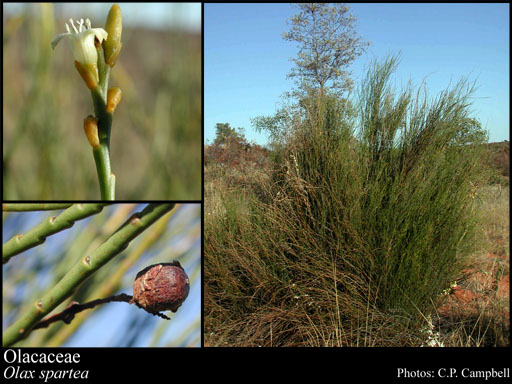- Reference
- Narr.Exped.Zaire 452 (1818)
- Name Status
- Current

Scientific Description
Common name. Olax Family.
Habit and leaf form. Trees, shrubs, and lianas; laticiferous, or non-laticiferous and without coloured juice; resinous, or not resinous. Autotrophic, or partially parasitic. When parasitic, on roots of the host. Self supporting, or climbing. Mesophytic, or xerophytic. Leaves alternate; spiral, or distichous (commonly); leathery; petiolate; non-sheathing; gland-dotted, or not gland-dotted; aromatic, or without marked odour, or foetid; simple. Leaf blades entire; one-veined, or pinnately veined; cross-venulate. Leaves without stipules. Leaf blade margins entire. Stem anatomy. Nodes unilacunar, or tri-lacunar, or multilacunar (rarely). Secondary thickening developing from a conventional cambial ring.
Reproductive type, pollination. Fertile flowers hermaphrodite, or functionally male and functionally female, or functionally male, or functionally female. Unisexual flowers present, or absent. Plants hermaphrodite, or monoecious, or dioecious.
Inflorescence and flower features. Flowers aggregated in ‘inflorescences’; in panicles, in racemes, and in heads. Inflorescences axillary. Flowers small; regular; cyclic. Free hypanthium present, or absent. Hypogynous disk present; annular. Perianth with distinct calyx and corolla (but the calyx lobes reduced); 6–12; 2 -whorled; isomerous. Calyx 3–6; 1 -whorled; gamosepalous; entire, or lobed; when not entire, lobulate, or blunt-lobed, or toothed; imbricate, or open in bud; cupuliform; regular; fleshy, or non-fleshy; persistent; accrescent (often), or non-accrescent. Corolla 3–6; 1 -whorled; polypetalous, or gamopetalous (basally, rarely forming a long tube); valvate; regular. Fertile stamens present, or absent (female flowers). Androecium 3–6, or 6–12, or 9–18. Androecial members free of the perianth, or adnate (to the corolla); free of one another, or coherent; sometimes 1 - adelphous (the filaments united basally); 1 -whorled. Androecium exclusively of fertile stamens, or including staminodes. Stamens 3–18; reduced in number relative to the adjacent perianth to polystemonous; when as many as C, alternisepalous. Anthers basifixed; versatile, or non-versatile; dehiscing via pores, or dehiscing via short slits, or dehiscing via longitudinal slits; tetrasporangiate. Fertile gynoecium present, or absent (from male flowers). Gynoecium (2–)3(–5) carpelled. The pistil 1–5 celled. Carpels isomerous with the perianth, or reduced in number relative to the perianth. Gynoecium syncarpous; synstylovarious, or eu-syncarpous; superior (usually), or partly inferior. Ovary unilocular, or plurilocular; (2–)3(–5) locular (basally— sometimes unilocular above), or 1 locular. Gynoecium stylate. Styles 1; apical. Stigmas 2–5 - lobed. Placentation when unilocular, free central; when plurilocular, axile, or axile to apical. Ovules in the single cavity when unilocular, (2–)3(–5); 1 per locule; pendulous; anatropous.
Fruit and seed features. Fruit fleshy, or non-fleshy; indehiscent; a drupe, or a nut (one seeded); enclosed in the fleshy hypanthium, or enclosed in the fleshy perianth, or without fleshy investment. Seeds endospermic. Endosperm oily. Cotyledons 2–6. Embryo chlorophyllous (1/2); straight. Seedling. Germination phanerocotylar, or cryptocotylar.
Physiology, biochemistry. Aluminium accumulation not found (with Octoknema excluded).
Geography, cytology, number of species. World distribution: pantropical and subtropical. X = 19, 20. 250 species.
Economic uses, etc. Edible fruit from Ximenia (false sandalwood, hog-plum).